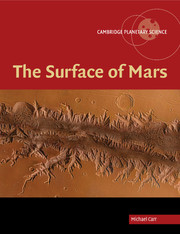11 - The view from the surface
Published online by Cambridge University Press: 12 August 2009
Summary
Our approach to elucidating the geology of Mars has of necessity been very different from the approach used for the Earth. Almost all our geological knowledge of the Earth is based on measurements made on the ground, on the chemistry, mineralogy, lithology, and orientation of rocks at the surface. In contrast, our perceptions about how Mars has evolved have been mostly derived from remote sensing data and a few martian meteorites of unknown provenance. However, geological processes and their sequence can rarely be uniquely identified solely by the configuration of the surface, and composition and lithology can only be coarsely inferred from spectra. This is particularly true on an alien planet where geological processes operate on different materials and under different conditions from our terrestrial experience. Generally, in situ measurements provide much more definitive clues about geological evolution. They also greatly enhance the value of any remote sensing data by providing ground truth against which the interpretation of the remote sensing data can be tested and extrapolated to other areas. At the time that this book was written we had made direct measurements on the martian surface at only five sites: the two Viking sites, the Pathfinder site, and the two Mars Exploration Rover sites. In this chapter we discuss what was found at these sites. The discussion mainly concerns the MER sites because of the diversity of materials that they were able to access and the quality of the data they returned.
- Type
- Chapter
- Information
- The Surface of Mars , pp. 229 - 256Publisher: Cambridge University PressPrint publication year: 2007



